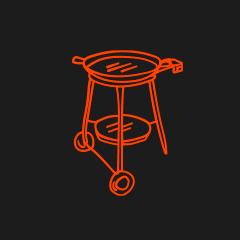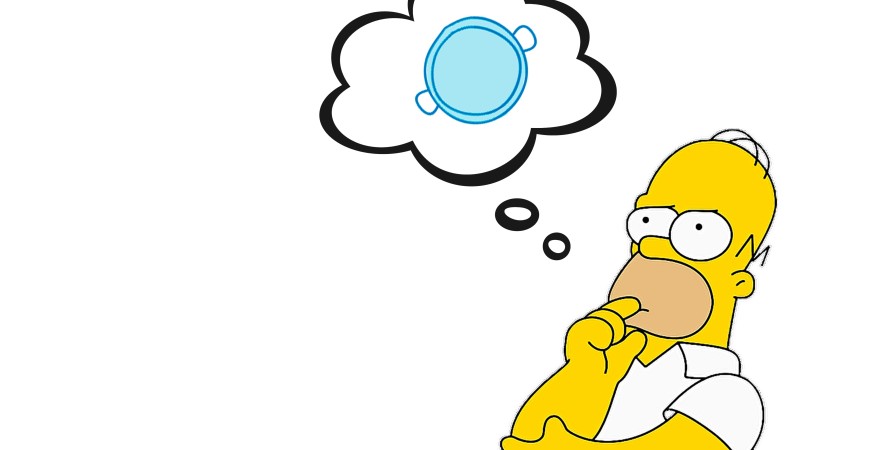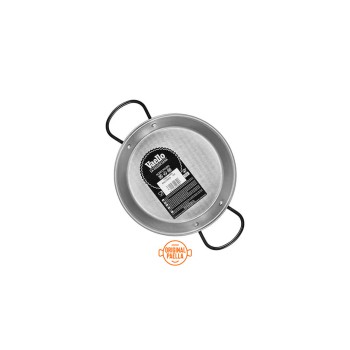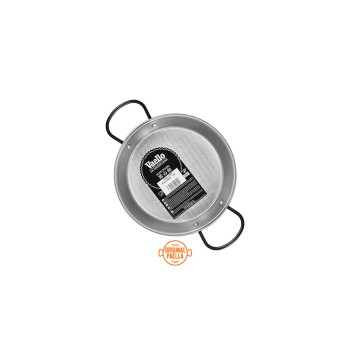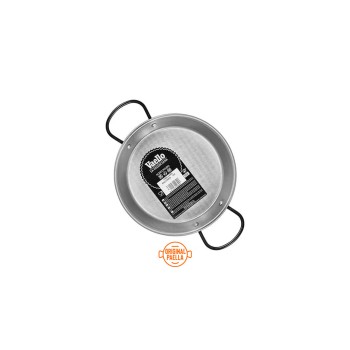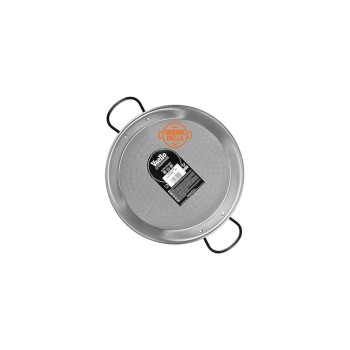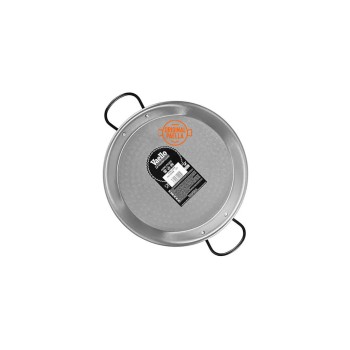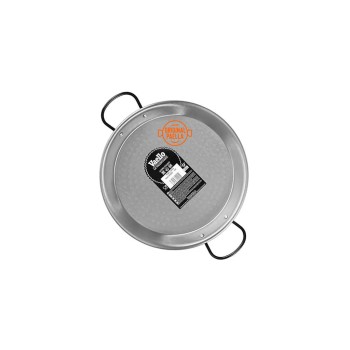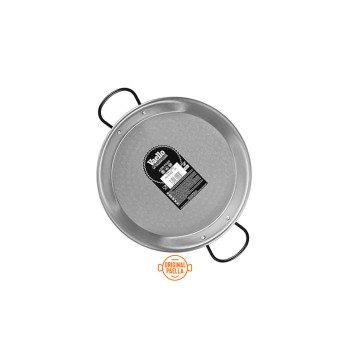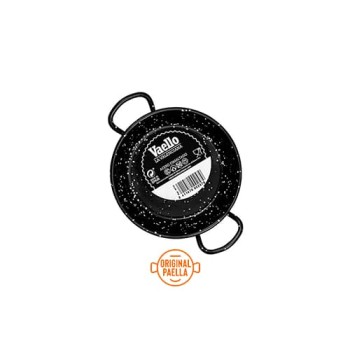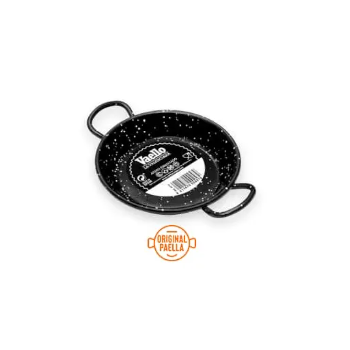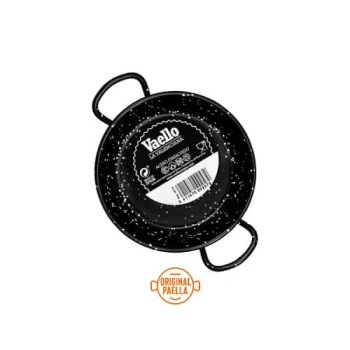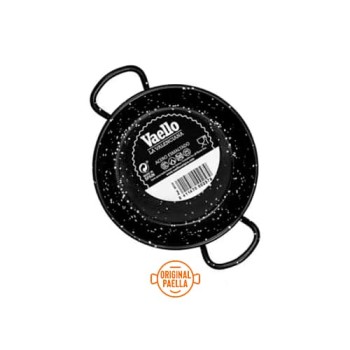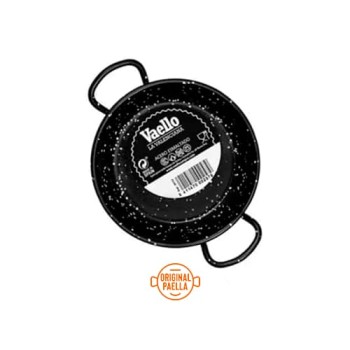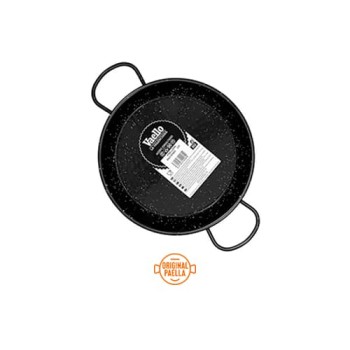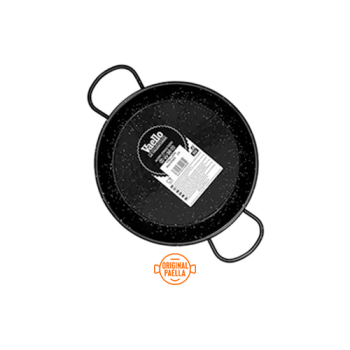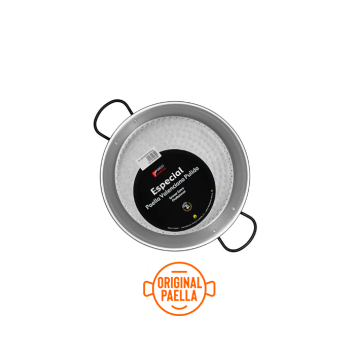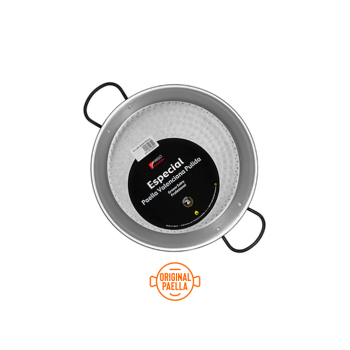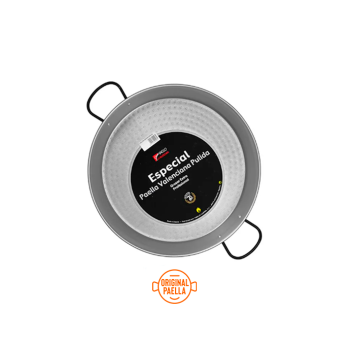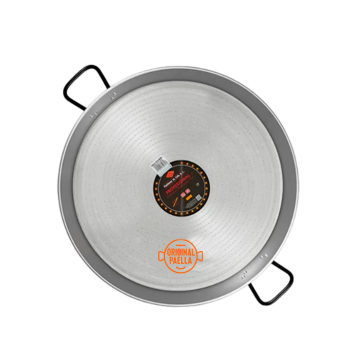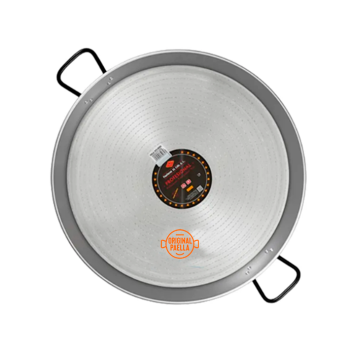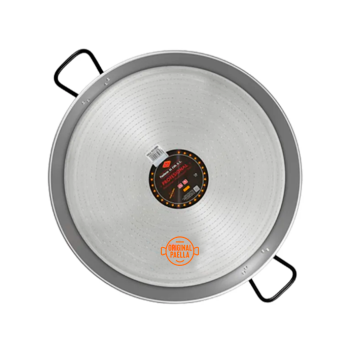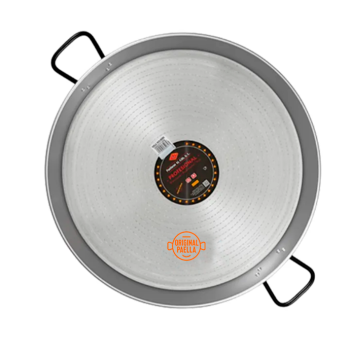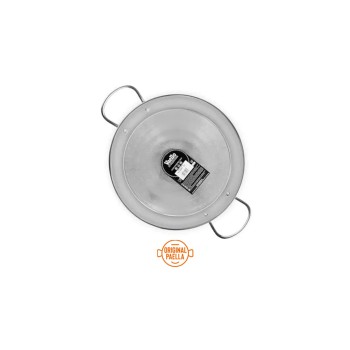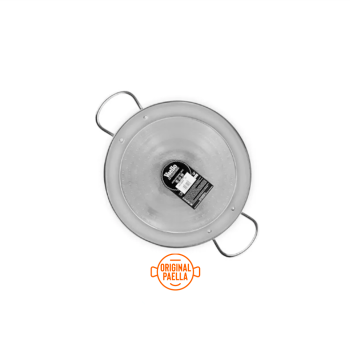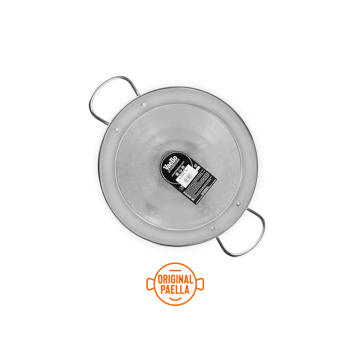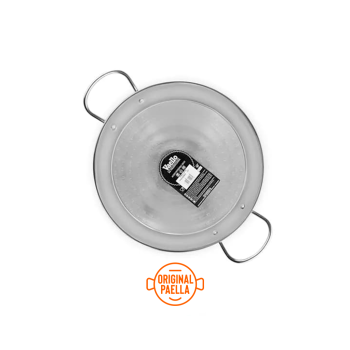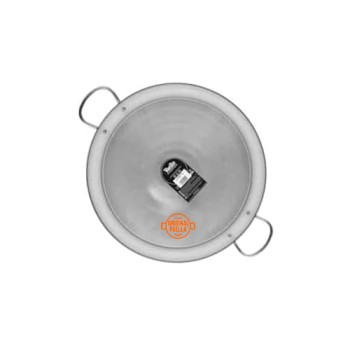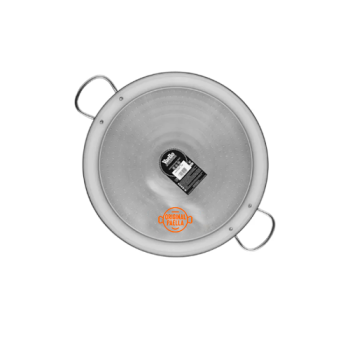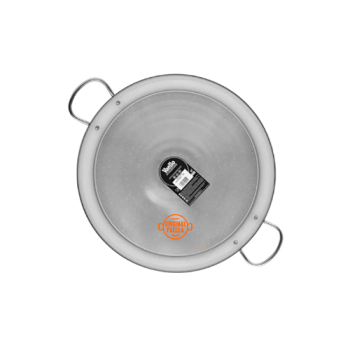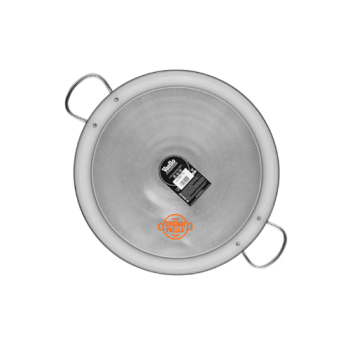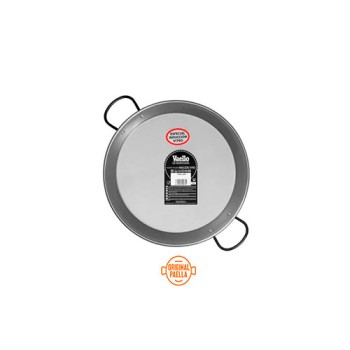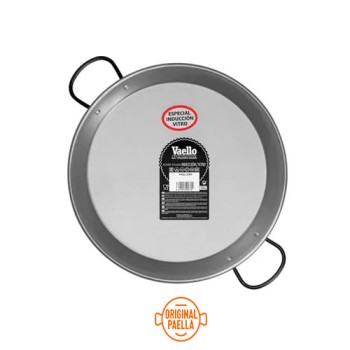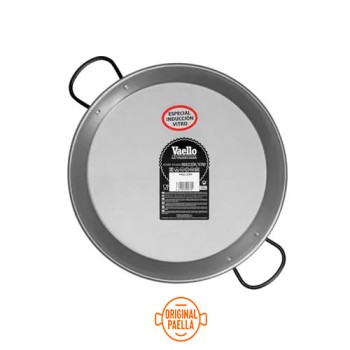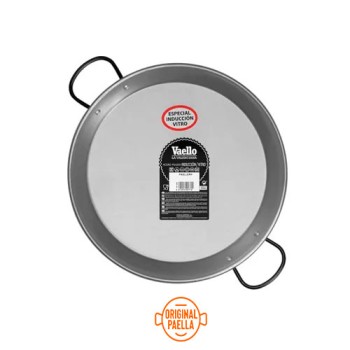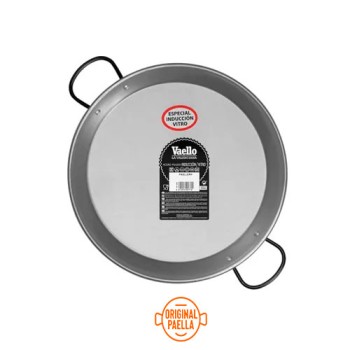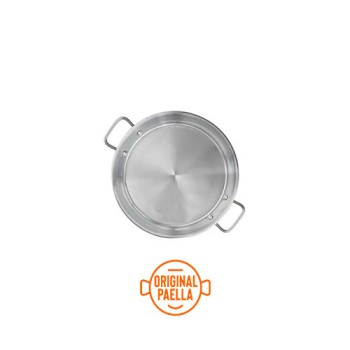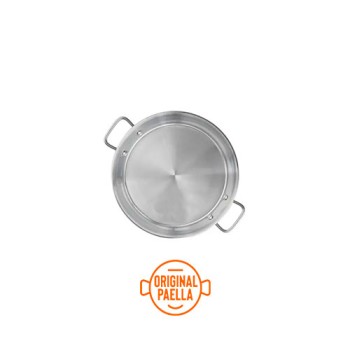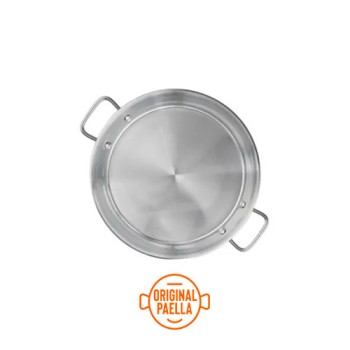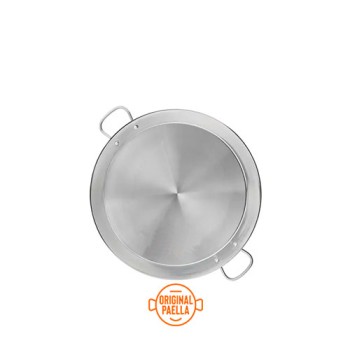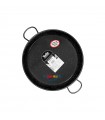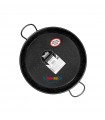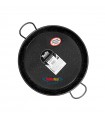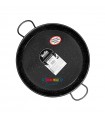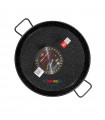¿What is the right size of paella pan for the amount of rations I want?
¿For how many people is this paella pan?,¿Can I fit 2 kilograms of rice in this paella?,¿What size of paella pan do I need to buy for 6 people?,¿Do I need to buy a new paella pan or the one I have more than suffices for what I want to do?
You probably have made one of these questions when you were planning dinner or event with your friends, companions, or family, leaving you indecisive and worried that if you would be able to make that paella you want to surprise them all with.
Don’t worry, we here at Originalpaella bring you a solution for this kind of doubts and similar in this concise table, you will only need to give it a cursory look too know if you have your perfect paella or need to buy a new one, we even offer you the exact number of rations that you can obtain with your paella pan.
Table of rations for paella pan size
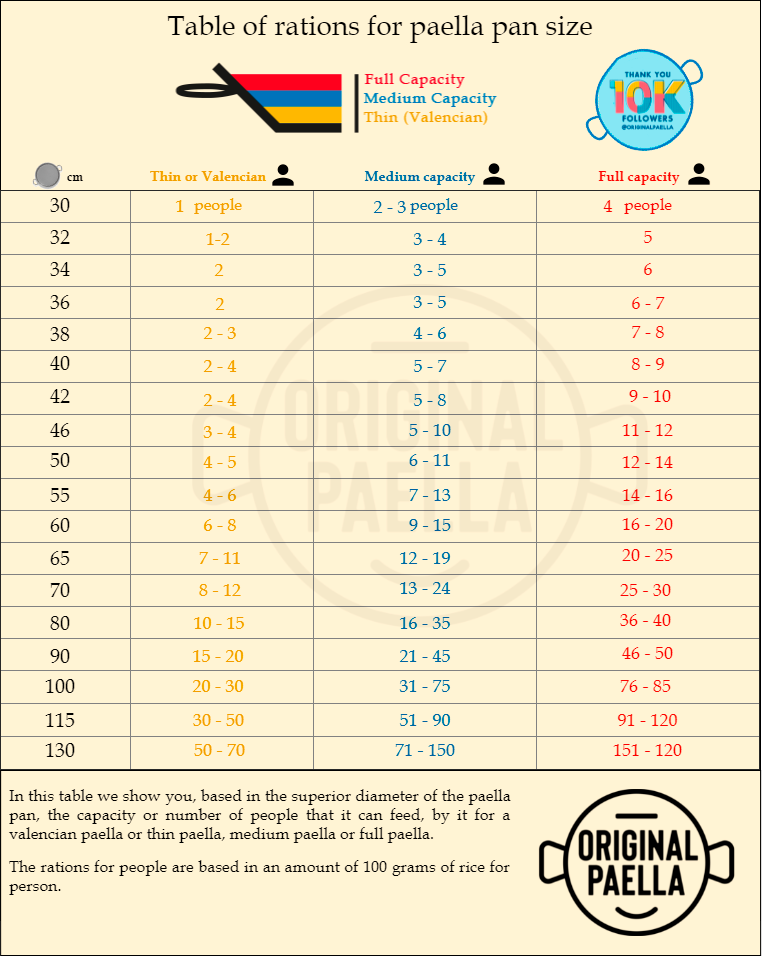
Click on this link to download the table
Table of number of people per type of paella ration desired
In this other table you have the same information, but ordered differently. Instead of indicating the diameter in cm of the paella that you need for the number of people you want to feed, we indicate in this table, based on the people you want to feed, the necessary diameter of paella, depending on whether that paella will be made in a thin layer. , half or full capacity.
| Paella Diameter | |||
| Paella for X people | Thin or Valencian | Medium capacity | Full capacity |
| Paella for 1 person | 30-32 cm | X | X |
| Paella for 2 people | 34-36-38-40-42 cm | X | X |
| Paella for 3 people | 38-40-42-46 cm | 30-32-34-36 cm | X |
| Paella for 4 people | 40-42-46-50-55 cm | 32-34-36-38 cm | 30 cm |
| Paella for 6 people | 55-60 cm | 38-40-42-46-50 cm | 34-36 cm |
| Paella for 8 people | 60-65 cm | 46-50-55 cm | 38-40 cm |
| Paella for 10 people | 65-70-80 cm | 46-50-55-60 cm | 42 cm |
| Paella for 12 people | 65-70 cm | 65 cm | 46-50 cm |
| Paella for 14 people | 80 cm | 60-65-75 cm | 50-55 cm |
| Paella for 16 people | 90 cm | 65-70-80 cm | 55-60 cm |
| Paella for 18 people | 90 cm | 65-70-80 cm | 60 cm |
| Paella for 20 people | 90-100 cm | 70-80 cm | 60-65 cm |
| Paella for 30 people | 100 cm | 80-90 cm | 70 cm |
| Paella for 40 people | 115 cm | 90-100 cm | 80 cm |
| Paella for 50 people | 115 cm | 100 cm | 90 cm |
| Paella for 60 people | 115-130 cm | 100-115 cm | 90-100 cm |
| Paella for 70 people | 130 cm | 100-115 cm | 90-100 cm |
| Paella for 80 people | X | 115 cm | 100 cm |
| Paella for 90 people | X | 115-130 cm | 115 cm |
| Paella for 100 people | X | 130 cm | 115 cm |
Click on this link to download the table
¿Pretty easy on the eyes, isn’t it?, don’t worry, even if the table itself explains much of herself alone, we can still give it a more profound analysis.
You can find the size of the paella pan in the left part of the table, all the dimensions are based in the superior diameter of the paella, as it allows us to know the surface we can cover with rice and our ingredients.
Types of paella rations
Following this, we offer you a division of the number of rations that you can obtain with your paella pan, keep in mind that these rations for person are based in 100 grams of dry rice for person, if you include more for each person, the measurement we provide you will not be accurate.

The division of rations follows the following hierarchical order:
Thin or Valencian layer
Marked with the yellow color in the table, it is the most common and classic way of preparing a paella. This way of cooking paella allows us to obtain a homogeneous cooking of the rice layer and the coagulation of a veil of fat and protein, which gives the paella a greater amount of flavor. Furthermore, since it is a minimal layer of rice, the proportion of socarrat is superior to other styles of making paella.
It is the variation of paella preparation that gives us fewer servings, but ensures maximum flavor and socarrat compared to other ways of preparing it.
Half capacity layer
Marked with the blue color in the table, it implies that we have filled the paella pan to half its capacity with rice. Even if it perfectly preserves its flavors, we will obtain a lower proportion of socarrat-rice than the Valencian layer, in the same way, the protein veil will affect a lower amount of rice, although we will preserve the flavor better than a full capacity layer.
It is the perfect option to prepare rice portions for an intermediate number of diners without sacrificing the flavor of the rice to a large extent.
Full capacity layer
Marked with the red color in the table, it implies that we have filled our paella pan to its maximum possible, with the rice almost reaching the upper edges.
Although it is the style that provides the greatest number of servings possible, most of the flavor of the paella will be concentrated in its lower part, because the upper part of the layer will absorb as much broth as it can and the rest will remain suffocated below. In the same way, the upper part will not enjoy a homogeneous cooking like the lower layer does. This does not necessarily imply that paella has lost its flavor, we will have sacrificed a more powerful overall flavor for a much larger number of servings than its other alternatives.
General recommendations
And if you have doubts about which paella burner or gas burner you would need for your paella pan, don't worry, we have another similar table on our blog, where we tell you which paella burner is necessary for the size of your paella pans and what range of paella dimensions each paella burner can cover.
We would also like to recommend you about which type of rices we could potentially use for our paella; we commonly recommend the use of round rice because these do not tend to open themselves during cooking. If you are looking to use a low paella or valencian, we recommend you the use of soft and round grain, such as senia or bahía rice, as it possesses a greater capacity of absorption of flavors as well as being more sensible to overcooking. If we where to use a high paella pan, we would recommend hard and round grain, such as bomba or Maratelli rice, which have a higher resistance to overcooking, but don’t absorb flavors as well as other alternatives.
We would recommend for the general use, just as we explain more in deep in our blog about types of rice, albufera rice, a hybrid within hard and soft round grain of rice which combines all its advantages without any of its disadvantages.
If you also have doubts about which kind of paella pan is more accurate for you, you can find information over which different kind of paella pans exists and their advantages and disadvantages in our blog.
If you want to see more content from our blog, follow this link.
¿For how many people is this paella pan?,¿Can I fit 2 kilograms of rice in this paella?,¿What size of paella pan do I need to buy for 6 people?,¿Do I need to buy a new paella pan or the one I have more than suffices for what I want to do?
You probably have made one of these questions when you were planning dinner or event with your friends, companions, or family, leaving you indecisive and worried that if you would be able to make that paella you want to surprise them all with.
Don’t worry, we here at Originalpaella bring you a solution for this kind of doubts and similar in this concise table, you will only need to give it a cursory look too know if you have your perfect paella or need to buy a new one, we even offer you the exact number of rations that you can obtain with your paella pan.
Table of rations for paella pan size
Table of number of people per type of paella ration desired
In this other table you have the same information, but ordered differently. Instead of indicating the diameter in cm of the paella that you need for the number of people you want to feed, we indicate in this table, based on the people you want to feed, the necessary diameter of paella, depending on whether that paella will be made in a thin layer. , half or full capacity.
| Paella Diameter | |||
| Paella for X people | Thin or Valencian | Medium capacity | Full capacity |
| Paella for 1 person | 30-32 cm | X | X |
| Paella for 2 people | 34-36-38-40-42 cm | X | X |
| Paella for 3 people | 38-40-42-46 cm | 30-32-34-36 cm | X |
| Paella for 4 people | 40-42-46-50-55 cm | 32-34-36-38 cm | 30 cm |
| Paella for 6 people | 55-60 cm | 38-40-42-46-50 cm | 34-36 cm |
| Paella for 8 people | 60-65 cm | 46-50-55 cm | 38-40 cm |
| Paella for 10 people | 65-70-80 cm | 46-50-55-60 cm | 42 cm |
| Paella for 12 people | 65-70 cm | 65 cm | 46-50 cm |
| Paella for 14 people | 80 cm | 60-65-75 cm | 50-55 cm |
| Paella for 16 people | 90 cm | 65-70-80 cm | 55-60 cm |
| Paella for 18 people | 90 cm | 65-70-80 cm | 60 cm |
| Paella for 20 people | 90-100 cm | 70-80 cm | 60-65 cm |
| Paella for 30 people | 100 cm | 80-90 cm | 70 cm |
| Paella for 40 people | 115 cm | 90-100 cm | 80 cm |
| Paella for 50 people | 115 cm | 100 cm | 90 cm |
| Paella for 60 people | 115-130 cm | 100-115 cm | 90-100 cm |
| Paella for 70 people | 130 cm | 100-115 cm | 90-100 cm |
| Paella for 80 people | X | 115 cm | 100 cm |
| Paella for 90 people | X | 115-130 cm | 115 cm |
| Paella for 100 people | X | 130 cm | 115 cm |
Click on this link to download the table
¿Pretty easy on the eyes, isn’t it?, don’t worry, even if the table itself explains much of herself alone, we can still give it a more profound analysis.
You can find the size of the paella pan in the left part of the table, all the dimensions are based in the superior diameter of the paella, as it allows us to know the surface we can cover with rice and our ingredients.
Types of paella rations
Following this, we offer you a division of the number of rations that you can obtain with your paella pan, keep in mind that these rations for person are based in 100 grams of dry rice for person, if you include more for each person, the measurement we provide you will not be accurate.

The division of rations follows the following hierarchical order:
Thin or Valencian layer
Marked with the yellow color in the table, it is the most common and classic way of preparing a paella. This way of cooking paella allows us to obtain a homogeneous cooking of the rice layer and the coagulation of a veil of fat and protein, which gives the paella a greater amount of flavor. Furthermore, since it is a minimal layer of rice, the proportion of socarrat is superior to other styles of making paella.
It is the variation of paella preparation that gives us fewer servings, but ensures maximum flavor and socarrat compared to other ways of preparing it.
Half capacity layer
Marked with the blue color in the table, it implies that we have filled the paella pan to half its capacity with rice. Even if it perfectly preserves its flavors, we will obtain a lower proportion of socarrat-rice than the Valencian layer, in the same way, the protein veil will affect a lower amount of rice, although we will preserve the flavor better than a full capacity layer.
It is the perfect option to prepare rice portions for an intermediate number of diners without sacrificing the flavor of the rice to a large extent.
Full capacity layer
Marked with the red color in the table, it implies that we have filled our paella pan to its maximum possible, with the rice almost reaching the upper edges.
Although it is the style that provides the greatest number of servings possible, most of the flavor of the paella will be concentrated in its lower part, because the upper part of the layer will absorb as much broth as it can and the rest will remain suffocated below. In the same way, the upper part will not enjoy a homogeneous cooking like the lower layer does. This does not necessarily imply that paella has lost its flavor, we will have sacrificed a more powerful overall flavor for a much larger number of servings than its other alternatives.
Different types of paella materials
Looking at these tables, a common question will surely have arisen in your mind: does the material of the paella pan affect the way it is cooked? The answer is a simple no, although there are different materials and methods with which the paella we cook has been created, there is no real difference in terms of its use during the preparation and cooking of the paella.
The differences in material do not change the final result of our paella, but it can change some of its characteristics for general use, such as greater heat resistance, better cleaning after use or allowing it to be used with other types of fires, such as induction/ vitroceramic.
In this next part we will show you the different paellas and their differences according to the material used for their construction:
Polished steel paella pans
Popularly known as the polished paella or steel paella, it is the traditional paella par excellence and the most recognisable. As it is made of steel, it obtains heat easily and distributes it over its surface quickly.
It should be taken into account that it requires maintenance after use to ensure its cleanliness and prevent rusting.
Enamelled paella pans
Also known under the name of black paella, its black enamel with white dots protects it from oxidation, making it easy to clean as it can be left to soak to remove dirt or hard remains of food.
Paella pans of special thickness
Referred to as pata negra paella, these paella pans have an extra thickness in their steel, which makes them perfect for wood fires or for constant and intensive use.
It should be noted that, like its thinner sister, the polished steel paella pan requires maintenance after cleaning and use to prevent rusting.
Stainless steel paella pans
The stainless steel paella pan combines the advantages of the polished steel paella pan and the enameled paella pan without suffering any of their disadvantages. It offers the polished finish of the traditional iron paella pan but with the antioxidant capabilities of the enameled steel paella pan. Thanks to this, it does not require any kind of maintenance and only requires cleaning with soap and water after each use.
Polished induction pans
The polished steel paella pan for induction is the most traditional paella, it distributes the heat evenly and quickly due to being made 100% of steel. It is susceptible to oxidation and requires maintenance, a layer of vegetable oil on its surface, after having been cleaned and dried after use.
Induction stainless steel paella pans
The induction stainless steel paella pan maintains its classic polished finish, adding to its characteristic antioxidant capabilities. It does not require maintenance and only requires washing with soap and water after use. This paella is also the only one that has a heat-diffusing bottom that contributes to the distribution of heat evenly throughout the base of the paella.
Enameled indccution paella pans
The induction enameled steel paella pan is covered with a layer of black enamel, sometimes speckled with white dots, which prevents oxidation. It does not require maintenance after use, but it is advised to clean it with the soft part of the scourer to avoid scratching the enamel and, due to this, eliminate its antioxidant properties.
General recommendations
And if you have doubts about which paella burner or gas burner you would need for your paella pan, don't worry, we have another similar table on our blog, where we tell you which paella burner is necessary for the size of your paella pans and what range of paella dimensions each paella burner can cover.
We would also like to recommend you about which type of rices we could potentially use for our paella; we commonly recommend the use of round rice because these do not tend to open themselves during cooking. If you are looking to use a low paella or valencian, we recommend you the use of soft and round grain, such as senia or bahía rice, as it possesses a greater capacity of absorption of flavors as well as being more sensible to overcooking. If we where to use a high paella pan, we would recommend hard and round grain, such as bomba or Maratelli rice, which have a higher resistance to overcooking, but don’t absorb flavors as well as other alternatives.
We would recommend for the general use, just as we explain more in deep in our blog about types of rice, albufera rice, a hybrid within hard and soft round grain of rice which combines all its advantages without any of its disadvantages.
If you also have doubts about which kind of paella pan is more accurate for you, you can find information over which different kind of paella pans exists and their advantages and disadvantages in our blog.
If you want to see more content from our blog, follow this link.

Javier Baixauli
Our CEO and founder, Javier Baixauli, naturally, is a huge paella lover. In this tutorial, he demonstrates his love for all things paella and rice. With over 20 years in the world of rice and hospitality, he combines his love for paella with the experience of hundreds of catering events, festivities, and popular celebrations, not to mention paellas among friends and family. Catering, paella equipment rentals, thousands of products sold worldwide, guides, tutorials, and in-person advice, Javier and the Original Paella team pride themselves on ensuring that the love for paella spreads worldwide with every action in their name, including, in this case, this tutorial. Follow and discover other tutorials, events, and recipes on our Instagram @originalpaella.



